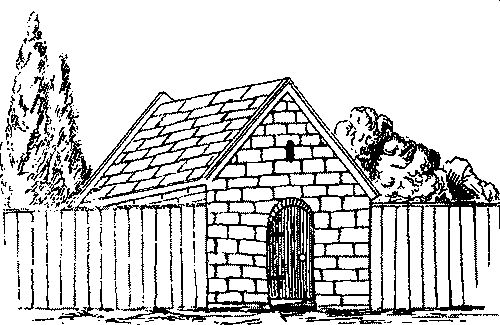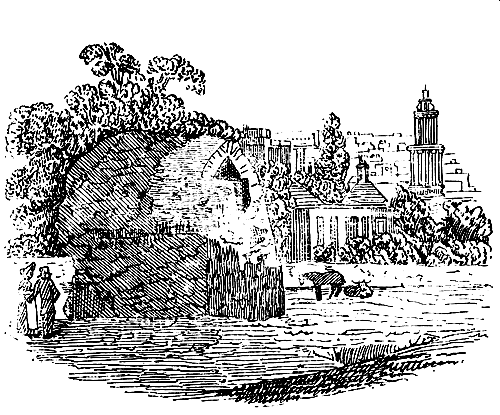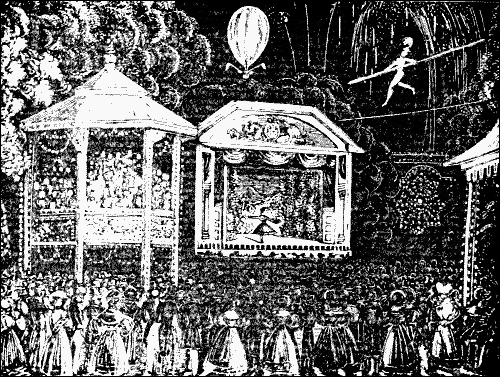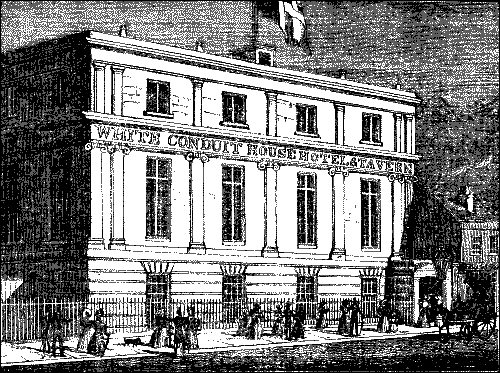

Search london history from Roman times to modern day
This London history site is a wiki of early London streets.
As the Fleet was "the River of Wells" it may be as well to notice the Wells, which, although not absolutely contributing towards swelling its volume, are yet closely adjacent--namely, White Conduit, and Sadlers Wells. Both of these, as indeed were all the other Wells about London, were first known as mineral springs, a fact which drew the middle classes to seek relief from real, or fancied, ailments, by drinking the medicinal waters, as at Bath, Epsom, Cheltenham, Harrogate, Brixton, and elsewhere. Wherever people congregate, the mere drinking of salutary water, is but tame work, and the animal spirits of some of them must find an outlet in amusements, which materially assist, to say the least, in the agreeable passing of time. But the mere drinking of waters must have been irksome--even if people took to it as well as _Shadwell_ in his play of "Epsom Wells" describes:--

[Illustration: THE WHITE CONDUIT.]
"_Brisket._ I vow it is a pleasurable Morning: the Waters taste so finely after being fudled last Night. Neighbour _Fribbler_ here's a Pint to you.
"_Fribbler._ I'll pledge you, Mrs. _Brisket_; I have drunk eight already.
"_Mrs. Brisket._ How do the Waters agree with your Ladyship?
"_Mrs. Woodly._ Oh, Sovereignly: how many Cups have you arrived to?
"_Mrs. Brisket._ Truly Six, and they pass so kindly."
By degrees these medicinal waters, or Spas, as they were termed in later times, fell into desuetude, possibly because medical knowledge was advancing; and the Wells, with their gardens attached, became places of outdoor recreation, where the sober citizen could smoke his pipe, and have his beer, or cider, whilst his wife, and her gossips, indulged in tittle tattle over their Tea--which, although much dearer than at present, was a very popular beverage, and so, from health resorts, they imperceptibly merged into the modern Tea Garden--which, in its turn, has become nearly extinct, as have the Ranelagh and Vauxhall of a former age; which, however, we have seen, in our time, somewhat resuscitated in the outdoor portion of the several Exhibitions which have taken place, in the few past years, at South Kensington.
The White Conduit had a history of its own, which we can trace back, at all events, to the fifteenth century, for it was built as a reservoir to supply what was, afterwards, the Charterhouse.
This we can see by a royal licence, dated December 2, 9 Henry VI. an. 1431,[21] which granted to John Feryby, and his wife Margery, that they might grant and assign to the Prior and Convent of the House of the Salutation of the Blessed Mary of the Carthusian Order, by London, a certain well spring (_fontein_) and 53 perches of land in length, and 12 feet in breadth, in the vill of Iseldon (Islington) to have to them and their successors for ever, and to the same Prior and Convent, to take the said land, and construct a certain subterraneous aqueduct from the aforesaid well spring, through the aforesaid land, and through the King's highway aforesaid, and elsewhere, as it may seem best &c., _non obstante_ the Act against mortmain (_Teste Humfride Duce Gloucestr' Custode Angliae apud Westm._).
As we know, Henry VIII. put an end to the Monastic Orders in England, and, at the dissolution of the Priory, the reversion of the site, and house thereof, was granted, on April 14, 1545,[22] to Sir Roger North, in fee, together with "all that the Head and original Well Spring of one Channel or Aqueduct situate and being in a certain field in the parish of Islington"--and it also gave, all the channels, aqueducts, and watercourses under ground "up to the site of the said House of the Carthusians."
But, although the spring might, and did, supply the Charter House, yet it is possible that the Conduit House, from which it got the name of _White_ Conduit, from its being built of white stone--was built by Thomas Sutton, who founded the Hospital of the Charter House,--in 1611. It was either built by him, or repaired in 1641, for, incorporated in the building, was a stone containing his arms--and initials.[23]
The other initials have not been identified. As the "White Conduit" it was known well into this century, but it fell somewhat into decay, about 1812--was never repaired, and, finally, was pulled down in 1831--to make way for the completion of some new buildings in Barnsbury Road, as a continuation of Penton Street: and the stone was broken up, and used in making the New Road.

[Illustration: STONE IN THE WHITE CONDUIT. _Gentleman's Magazine_, vol. lxxi. p. 1161, A.D. 1801.]
So much for the Conduit itself; but it, although inert, exercised a large share in the amusements of Londoners down to a comparatively recent period. It was pleasantly situated in the fields, and, until this century, during the latter half of which, the modern Babylon has become one huge mass of bricks and mortar, it served as a pleasant place of recreation for the Cits. There was an uninterrupted prospect of Hampstead and Highgate--which bounded the northern view, and which was purely pastoral, with the exception of sparsely-dotted farmhouses. There is a tradition that, on the site of the comparatively modern _White Conduit House_, was (in the reign of Charles I.), a tavern in the course of erection, and that, being finished, the workmen were carousing at the very moment of the monarch's decapitation.
Doubtless, in these suburban fields, there was, for very many years, a place for refreshment, which probably took the form, in the Arcadian age of the seventeenth and eighteenth century, of new milk, curds and whey, and syllabubs, for Islington was famous for its dairy produce,[24] as we know by the account of the entertainment given to Queen Elizabeth at Kenilworth Castle in 1575 by the Earl of Leicester, when the Squier Minstrel of Middlesex made a long speech in praise of Islington, whose motto was said to be, "Lactis Caseus infans."
The earliest really authentic notice of the White Conduit House, I can find, is in the _Daily Advertiser_ August 10, 1754. "This is to acquaint the public, that, at the White Conduit House, the proprietor, for the better accommodation of the gentlemen and ladies, has completed a long walk, with a handsome circular Fish-pond, a number of shady, pleasant arbours inclosed with a fence 7 feet high to prevent being the least incommoded from the people in the fields. Hot loaves,[25] and butter every day, milk directly from the Cows; coffee and tea, and all manners of liquors in the greatest perfection: also a handsome Long Room, from whence is the most Copious prospects and airy situation of any now in vogue. I humbly hope the continuance of my friends' favours, as I make it my chief study to have the best accommodations, and am, Gentlemen and Ladies, your obliged humble servant, Robert Bartholomew. _Note._ My Cows eat no grains, neither any adulteration in the Milk or Cream. Bats and Balls for Cricket, and a convenient field to play in."
This gives us a very fair insight into the sober relaxations of our great-great-grandfathers: and that the White Conduit House was, about this time, a resort for harmless recreation; and, certainly, it would rejoice the modern temperance enthusiasts to find that the principal beverages there drank were "non-intoxicants." Oliver Goldsmith used frequently to go there, walking from his house at Islington; and, in his "Citizen of the World," letter 122, he writes, "After having surveyed the Curiosities of this fair and beautiful town, I proceeded forward, leaving a fair stone building on my right; here the inhabitants of London often assemble to celebrate a feast of hot rolls and butter. Seeing such numbers, each with their little tables before them, employed on this occasion, must no doubt be a very amusing sight to the looker-on, but still more so to those who perform in the Solemnity."
And the same story of simplicity of amusement, and refreshment, is amusingly told in the _Gentleman's Magazine_ for May, 1760, vol. xxx. p. 242, in a short poem by William Woty, the author of the "Shrubs of Parnassus, consisting of a variety of poetical essays, moral and comic, by I. Copywell, of Lincoln's Inn, Esq. 1760."
"_And to_ White Conduit _House We will go, will go, will go_."
Grub Street _Register_.
"Wish'd Sunday's come--mirth brightens ev'ry face, And paints the rose upon the housemaid's cheek _Harriot_, or _Mol_ more ruddy. Now the heart Of prentice resident in ample street, Or alley, Kennel-wash'd _Cheapside_, _Cornhill_ Or _Cranborne_, thee, for calcuments renown'd, With joy distends. His meal meridian o'er, With switch in hand, he to _White Conduit_ house Hies merry hearted. Human beings here In couples multitudinous assemble, Forming the drollest groupe, that ever trod Fair Islingtonian plains. Male after male, Dog after dog, succeeding--husbands--wives-- Fathers and mothers--brothers--sisters--friends-- And _pretty little boys and girls_. _Around, Across, along_, the garden's shrubby maze, They walk, they sit, they stand. What crowds press on, Eager to mount the stairs, eager to catch First vacant bench or chair in _long-room_ plac'd. Here prig with prig holds conference polite, And indiscriminate, the gaudy beau, And sloven mix. Here _he_, who all the week Took bearded mortals by the nose, or sat Weaving dead hairs, and whistling wretched strain, And eke the sturdy youth, whose trade it is Stout oxen to contend, with gold bound hat, And silken stocking strut. The red-arm'd belle Here shews her _tasty_ gown, proud to be thought The butterfly of fashion: and, forsooth, Her haughty mistress deigns for once to tread The same unhallow'd floor. 'Tis hurry all, And ratling cups and saucers. Waiter here, And waiter there, and waiter here _and_ there, At once is call'd--_Joe--Joe--Joe--Joe--Joe-- Joe_ on the right--and _Joe_ upon the left, For ev'ry vocal pipe re-ecchoes _Joe_. Alas, poor _Joe_! Like _Francis_ in the play He stands confounded, anxious how to please The many-headed throng. But shou'd I paint The language, humours, customs of the place, Together with all curtsy's lowly bows,
And compliments extern, 'twould swell my page Beyond it's limits due. Suffice it then, For my prophetic muse to say, 'So long As fashion rides upon the Wing of time, While tea and cream, and buttered rolls can please, While rival beaux, and jealous belles exist, So long _White Conduit_ house, shall be thy fame.
W. W."
Later on in the century, it was still a reputable place of resort. In 1774, there was a painting at one end of the garden, the perspective of which served, artificially, to augment its size; the round fish-pond in the centre of the garden, still existed, and the refreshment-rooms, or boxes, were hung with Flemish and other pictures.
Hone ("Every Day Book," vol. ii. p. 1201, &c.) says, "About 1810, the late celebrated Wm. Huntingdon S.S.[26] of Providence Chapel, who lives in a handsome house within sight, was at the expense of clearing the spring for the use of the inhabitants; but, because his pulpit opinions were obnoxious, some of the neighbouring vulgar threw loads of soil upon it in the night, which rendered the water impure, and obstructed its channel, and, finally, ceasing to flow, the public was deprived of the kindness he proposed. The building itself, was in a very perfect state at that time, and ought to have been boarded up after the field it stood in was thrown open. As the new buildings proceeded, it was injured, and defaced, by idle labourers and boys, from mere wantonness, and reduced to a mere ruin. There was a kind of upper floor or hayloft in it, which was frequently a shelter to the houseless wanderer. A few years ago some poor creatures made it a comfortable hostel for the night with a little hay. Early in the morning a passing workman perceived smoke issuing from the crevices, and as he approached, heard loud cries from within. Some mischievous miscreants had set fire to the fodder beneath the sleepers, and, afterwards, fastened the door on the outside: the inmates were scorched by the fire, and probably they would all have been suffocated in a few minutes, if the place had not been broken open.

[Illustration: THE WHITE CONDUIT.]
"The 'White Conduit' at this time (1826) merely stands to those who had the power, and neglected to preserve it.
"To the buildings grown up around, it might have been rendered a neat ornament, by planting a few trees, and enclosing the whole with an iron railing, and have stood as a monument of departed worth.
"'White Conduit House' has ceased to be a recreation in the good sense of the word. Its present denomination is the 'Minor Vauxhall,' and its chief attraction during the passing summer has been Mrs. Bland.[27] She has still powers, and, if their exercise here, has been a stay and support to this sweet melodist, so far the establishment may be deemed respectable. It is a ground for balloon flying and skittle playing, and just maintains itself above the very lowest, so as to be one of the most doubtful places of public resort. Recollections of it some years ago are more in its favour. Its tea gardens then, in summer afternoons, were well accustomed by tradesmen and their families; they are now comparatively deserted, and, instead, there is, at night, a starveling show of odd company and coloured lamps, a mock orchestra, with mock singing, dancing in a room which decent persons would prefer to withdraw their young folks from, if they entered, and fireworks 'as usual,' which, to say the truth, are, usually, very good."

[Illustration: WHITE CONDUIT GARDENS (INTERIOR).]

[Illustration: WHITE CONDUIT GARDENS (EXTERIOR).]
As time went on, the place did not improve, as we may see by the _New Monthly Magazine_ for 1833, in an article--part of "Four Views of London." Speaking of the White Conduit--"Here too is that Paradise of apprentice boys, White _Cundick Couse_, as it is cacophoniously pronounced by its visitors, which has done much to expel the decencies of the district. Thirty years ago this place was better frequented--that is, there was a larger number of respectable adults--fathers and mothers, with their children, and a smaller moiety of shop lads, and such like Sunday bucks, who were awed into decency by their elders. The manners, perhaps, are much upon a _par_ with what they were. The ballroom gentlemen then went through country dances with their hats on, and their coats off:--hats are now taken off, but coats are still unfashionable on these gala nights. The belles of that day wore long trains to their gowns: it was a favourite mode of introduction to a lady there, to tread on it, and then, apologizing handsomely, acquaintance was begun, and soon ripened into an invitation to tea, and the hot loaves for which these gardens were once celebrated. Being now a popular haunt, those who hang on the rear of the march of human nature, the suttlers, camp followers, and plunderers, know that where large numbers of men and boys are in pursuit of pleasure, there is a sprinkling of the number to whom vice and debauchery are ever welcome: they have, therefore, supplied what these wanted; and Pentonville may now hold up its head, and boast of its depravities before any part of London."[28]
It got more and more disreputable, until it was pulled down in 1849, and the present White Conduit Tavern was built upon a portion of its site.
[Footnote 21: Cart. Antiq. in Off. Augm. vol. ii. No. 43.]
[Footnote 22: Pat. 36 Henry VIII. p. 13, m. 31.]
[Footnote 23: See next page.]
[Footnote 24: In an early sixteenth century book (unique) printed by Wynkyn de Worde, called "Cocke Lorelles Boke" the dairy farming at Islington is mentioned--
"Also mathewe to the drawer of London, And sybly sole mylke-wyfe of Islington."]
[Footnote 25: These Rolls were as famous as Chelsea Buns. "White Conduit loaves" being a familiar street cry.]
[Footnote 26: This revivalist used these initials as meaning "Sinner Saved."]
[Footnote 27: A somewhat famous singer in the latter part of the eighteenth and first quarter of the nineteenth centuries. She sang and acted at Drury Lane and the Haymarket--and also sang at Vauxhall. She became poor, and on July 5, 1824, she had a benefit at Drury Lane, which, with a public subscription, produced about L800. Lord Egremont also allowed her L80 a year. She was somewhat related to Royalty: her husband, Bland, an actor at Drury Lane, being the brother of Mrs. Jordan, who was the wife of William the Fourth.]
[Footnote 28: A frequent visitor at these gardens was the late George Cruikshank, and many subjects were transferred to his sketch book. He was so well known, as to become a sort of terror to the habitues of the place, and children were threatened, when fractious, "that if they made such ugly faces, Mr. Cruikshank would put them in his book."]
Trying to avoid privacy and cookie settings overwriting content